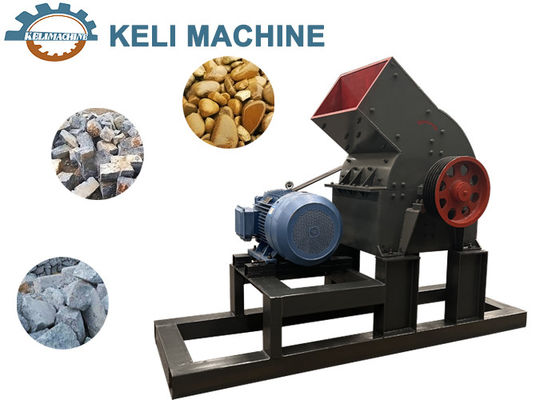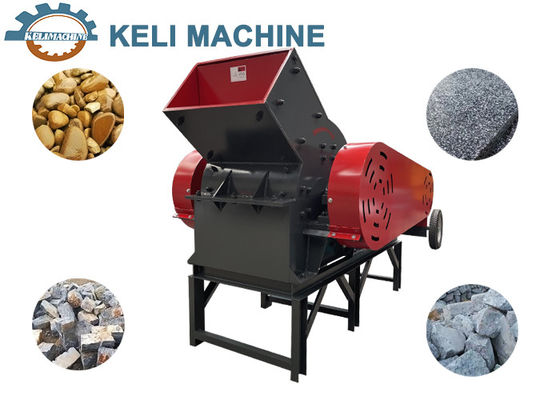Product Description:
The hammer crusher is suitable for crushing coarse, medium and medium-hard brittle and abrasive materials such as limestone, coal gangue, gypsum and shale with a compressive strength of less than 180 MPa (not exceeding 100 MPa) and a water content of less than 15%. It is suitable for crushing medium hardness materials in industrial sectors such as cement, chemical, electric power and metallurgy. The material with a maximum particle size of 600-1800mm can be directly crushed to 25mm or less.
It is also used to crush waste of wood, paper and broken asbestos cement with strong fiber structure, elasticity and toughness to recover asbestos fiber and so on. Hammer crusher is currently divided into two types: heavy and light. The ring hammer type coal crusher (light ring hammer crusher) is suitable for the crushing of Mohs hardness secondary materials, using broken coal ring hammer. The ring hammer crusher (heavy ring hammer crusher) is suitable for the crushing of brittle materials with a Mohs hardness of less than five grades, using a gravel ring hammer.
The quality of the gravel ring hammer is greater than the mass of the broken coal ring hammer, thereby increasing the impact force of the ring hammer and achieving the purpose of crushing the ore.
Advantages and disadvantages:
The advantages of hammer crusher are: great crushing ratio (generally 10-25, high up to 50), higher production capacity, more even product, lower over-powder phenomenon, reduced energy consumption per unit of product, more simple structure, lighter equipment quality, easier operation and maintenance, etc. The series of hammer crushers are widely used in crushing various medium hardness and brittle materials, such as limestone, coal, salt, baiya, gypsum, alum, brick, tile, gangue, etc.. Pressure strength of the crushed materials does not exceed 150 MPa. They are mainly used in cement, coal selection, power generation, building materials and compound fertilizer industries, etc. Its ability to crush raw materials of different sizes into uniform particles for lower-process processing, reliable mechanical structure, high-efficiency production and good applicability.
The disadvantages of hammer crusher are: wear and tear of hammer head and castor screen are fast, and it takes a long time to overhaul and find balance, and even faster when crushing hard material materials; in crushing sticky and wet materials, the seam of castor screen is easily blocked, and for this reason, it is easy to cause downtime (the water content of materials should not exceed 10%). For crushing hard materials, the hammer head and liner plate are worn out, the metal material is consumed more, and it needs more maintenance time to replace the wearable parts frequently.
When crushing sticky and wet materials, the castor is easy to be blocked and the production capacity is reduced. Therefore, it is used to crush various medium-hard and weakly abrasive materials. It has a compressive strength of not more than 100 MPa and a moisture content of less than 15%. Suitable materials for crushing are coal, salt, chalk, gypsum, brick and tile, limestone, etc. In the ring hammer crusher, the main working part is the rotor with hammer head.
Technical Parameters:
| Model |
PC300x200 |
PC400x300 |
PC600x400 |
PC800x600 |
PC1000x800 |
PC1000x1000 |
|
Feed particle size
(mm)
|
100 |
200 |
250 |
250 |
350 |
350 |
|
Discharge particle size
(mm)
|
8 |
25 |
30 |
35 |
35 |
35 |
|
Productivity
(t/h)
|
1-5 |
5-10 |
10-22 |
18-40 |
25-50 |
30-55 |
| Number of motor poles |
4 |
4 |
4 |
4 |
4 |
6 |
|
Power
(kw)
|
5.5 |
11 |
11-22 |
30-55 |
75 |
90 |
|
Dimensions
(mm)
|
630*380
*630
|
900*670
*860
|
1200*1050
*1200
|
1310*1180
*1310
|
1600*1390
*1575
|
1800*1590
*1775
|
|
Machine weight
(kg)
|
200 |
800 |
1500 |
3200 |
4300 |
8000 |
Product Show:


 Your message must be between 20-3,000 characters!
Your message must be between 20-3,000 characters! Please check your E-mail!
Please check your E-mail!  Your message must be between 20-3,000 characters!
Your message must be between 20-3,000 characters! Please check your E-mail!
Please check your E-mail! 













